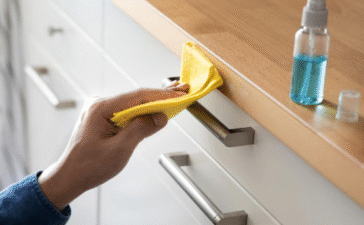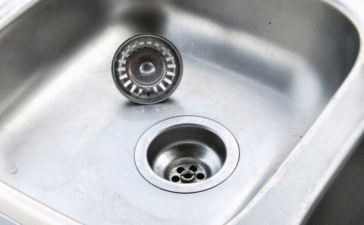The kitchen sink is more than just a place to wash dishes; it’s the operational heart of your kitchen. It’s where you rinse produce, fill pots, and handle daily cleanup. Choosing the right sink has a significant impact on your kitchen’s functionality and overall design aesthetic. Among the various styles available, the drop in sink remains a consistently popular choice for its straightforward installation and timeless appeal.
So, what exactly is a drop in kitchen sink? Also known as a top-mount or self-rimming sink, a drop in sink is designed to be lowered into a pre-cut hole in the countertop. Its defining feature is the visible rim that rests on the countertop, supporting the sink’s weight. This design makes it one of the most common and accessible options for kitchen renovations and new builds alike.
This guide will walk you through everything you need to know about drop in sinks. We will explore how they compare to other styles, the best materials and brands, detailed installation steps, and maintenance tips to ensure your sink remains a durable and beautiful part of your kitchen for years to come.
drop in Sink vs. Undermount Sink: Which is for You?
When choosing a kitchen sink, one of the first decisions you’ll face is whether to go with a drop in or an undermount style. Both have distinct advantages and are suited for different needs and kitchen designs.
An undermount sink is installed from below the countertop, creating a seamless transition from the counter surface to the sink basin. This design offers a sleek, modern look and makes cleaning easier, as you can wipe crumbs and spills directly into the sink without a rim getting in the way. However, undermount sinks are generally more expensive and require professional installation, as they must be securely bonded to the underside of the counter. They are also only compatible with solid-surface countertops like granite, quartz, or marble, as laminate or tile countertops cannot support the weight.
On the other hand, a drop in sink features a visible rim that rests on the countertop. This makes installation significantly easier and more DIY-friendly. drop in sinks are typically more affordable and compatible with any countertop material, including laminate. The main drawback is that the rim can trap food particles and grime, making cleaning slightly more challenging. The look is more traditional, which can be a pro or a con depending on your kitchen’s style. For those prioritizing budget, ease of installation, and a classic aesthetic, a drop in sink is an excellent choice.
Choosing the Best drop in kitchen sink
With so many options on the market, finding the perfect drop in sink can feel overwhelming. Focusing on trusted brands and key features can simplify your search. Brands like Kohler, Moen, and Kraus consistently receive positive drop in sink reviews for their quality, durability, and design innovation.
When evaluating your options, consider these critical factors. First is the material, which we will explore in detail in the next section. Second is the size and configuration. Measure your cabinet and countertop space carefully to determine the maximum sink dimensions you can accommodate. A standard kitchen sink is about 22 inches front-to-back and 30-33 inches wide. Also, decide between a single or double basin. Single-basin sinks offer a large, uninterrupted space ideal for washing large pots and pans. Double-basin sinks provide two separate areas for multitasking, such as washing in one side and rinsing in the other.
Finally, look at the depth. Deeper basins can hold more dishes and reduce splashing but may be less comfortable for taller individuals to use. Your choice should align with your daily needs; a large family might benefit from a deep, double-basin sink, while a small kitchen might be better suited for a compact single-basin model.
A Guide to drop in Sink Materials
The material of your sink is one of its most important features, affecting its durability, appearance, maintenance, and cost. Understanding the pros and cons of the best kitchen sink materials will help you make a confident decision.
Stainless steel is the most popular choice for its affordability, durability, and resistance to heat and stains. When shopping for a stainless steel sink, pay attention to the gauge; a lower gauge number (16-18) indicates thicker, more durable steel that is less prone to denting and noise.
Granite composite sinks are made from a mix of crushed granite and acrylic resin. They offer a modern, high-end look and are exceptionally durable, with high resistance to scratches, stains, and heat. The choice between a granite composite sink vs. stainless steel often comes down to aesthetics and budget, as granite composite models are typically more expensive.
Porcelain sinks provide a classic, glossy finish that is easy to clean. However, they are susceptible to chipping or cracking from heavy impacts. A more durable alternative is cast iron, which has a porcelain enamel coating. These sinks are incredibly heavy and long-lasting but can still chip if a heavy object is dropped on them.
Fireclay sinks are another excellent option, known for their durability and timeless farmhouse appeal. Fired at extremely high temperatures, fireclay is resistant to scratches, stains, and chipping, making it a robust choice when comparing stainless steel vs. fireclay sinks.
How to Install a drop in kitchen sink
One of the main advantages of a drop in sink is its relatively simple installation process, which a confident DIYer can often complete. Before you begin, gather your tools: a jigsaw, silicone caulk, a caulk gun, a pencil, measuring tape, and plumber’s putty.
First, if you are replacing an old sink, turn off the water supply and disconnect the plumbing. Carefully remove the old sink. For a new installation, place the sink or the provided template upside down on the countertop and trace the outline. Then, draw a cutting line about half an inch inside the traced line. Drill pilot holes in the corners of your cutting line and use a jigsaw to cut the opening.
Next, apply a bead of silicone caulk around the edge of the countertop opening. Carefully lower the sink into place, pressing down firmly to create a tight seal. From underneath, attach the mounting clips that came with the sink to secure it to the countertop. Wipe away any excess caulk from the top. Finally, install the faucet and connect the drain and water supply lines. Check for leaks before turning the water back on fully.
While this process is straightforward, mistakes like improper sealing can lead to leaks and water damage. If you are not comfortable cutting your countertop or handling plumbing, it is always best to hire a professional.
Maintaining Your drop in kitchen sink
Proper maintenance will keep your drop in sink looking great for years. Daily cleaning is simple; a gentle soap and water rinse is usually sufficient. For stainless steel, you can use a mixture of vinegar and water to remove water spots. Avoid abrasive cleaners or steel wool, which can scratch the surface.
To prevent stains and scratches, consider using a sink grid or mat at the bottom of the basin. This is especially helpful for porcelain and fireclay sinks. For granite composite sinks, it’s recommended to re-seal them annually to maintain their non-porous surface. Small chips in porcelain or enamel can often be repaired with a touch-up kit. To deal with rust on stainless steel, a non-abrasive cleaner and a soft cloth can effectively remove it.
The True Cost of a drop in Sink
The price of a drop in sink can vary widely based on material, brand, and size. You can find affordable drop in sinks made of basic stainless steel for as little as $150. Mid-range options, including higher-quality stainless steel or basic granite composite, typically fall between $300 and $600. Premium models made from fireclay, cast iron, or high-end granite composite can cost $800 or more.
While it might be tempting to opt for the cheapest option, investing in a higher-quality sink can offer better long-term value. More durable drop in kitchen sinks are less likely to scratch, dent, or stain, saving you money on repairs or early replacement. You can find drop in sinks at home improvement stores like Home Depot or Lowe’s, as well as through online retailers, which often offer a wider selection.
Smart drop in Sink Accessories
The right drop in sink accessories for your kitchen can significantly enhance its functionality. Custom-fit cutting boards that sit over the sink create extra counter space for food prep. Sink grids protect the bottom of the basin from scratches and allow dishes to dry. Other useful additions include soap dispensers, colanders, and drain baskets that make daily kitchen tasks more efficient.
Designing with Your drop in Sink
A drop in sink can fit seamlessly into any kitchen aesthetic. For a modern look, choose a sleek stainless steel or a dark granite composite sink with clean lines. In a traditional kitchen, a white porcelain or cast iron sink complements classic cabinetry. For a rustic or farmhouse style, a fireclay sink is the perfect centerpiece. When considering kitchen sink design ideas, think about how the sink’s material and color will coordinate with your countertops, faucet, and hardware.
Your drop in Sink Questions Answered
This section addresses common questions about choosing and maintaining a drop in sink to help you make the best decision.
What is the most durable material for a drop in kitchen sink?
Granite composite and fireclay are among the most durable materials. They are highly resistant to scratches, stains, and heat. High-quality, low-gauge (16-18) stainless steel is also very durable and resistant to impact.
Can I install a drop in sink on a granite countertop?
Yes, drop in sinks are compatible with all countertop materials, including granite, quartz, laminate, and wood. The sink’s rim rests on top of the counter, making the material type less of a structural concern compared to undermount sinks.
How do I choose the right size for my kitchen sink?
Your sink size should be proportional to your kitchen and cabinet size. A standard 30-inch-wide sink fits well in a 33-inch or larger cabinet base. For smaller kitchens or secondary prep areas, a sink width of 24 inches or less may be more appropriate. Always refer to the manufacturer’s kitchen sink size guide for specific cabinet requirements.
Are double-basin sinks better than single-basin sinks?
This depends on your personal workflow. Double basins are excellent for multitasking—washing on one side, rinsing or drying on the other. Single basins provide a large, open space that is ideal for washing large pots, pans, and baking sheets that wouldn’t fit in a divided sink.
How often should I re-caulk my drop in sink?
You should inspect the caulk around your sink annually for any signs of cracking, peeling, or mold. If the seal is compromised, you should remove the old caulk and apply a fresh bead of silicone to prevent leaks and water damage.
Also Read: “outdoor kitchen sink“
Final Thoughts on Your Kitchen Upgrade
Choosing the right drop in kitchen sink comes down to balancing material, size, style, and budget. By carefully considering your daily needs and design preferences, you can select a sink that not only enhances your kitchen’s functionality but also serves as a lasting focal point. Whether you opt for the modern durability of granite composite, the timeless appeal of fireclay, or the classic utility of stainless steel, a well-chosen drop in sink is a valuable investment in your home.
Ready to find the perfect sink for your kitchen? Browse our curated reviews of the top drop in sinks on the market or connect with a professional for expert installation services to ensure your new sink is fitted perfectly.












